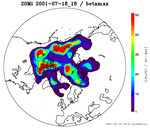Model description of MIMAS
A 3-d Lagrangian ice transport model called MIMAS is superimposed on LIMA which allows to study the formation and life cycle of ice particles in the polar mesopause region. MIMAS includes modules for a simplified mesospheric chemistry and transport of water vapor, and a Lagrangian transport and microphysical scheme of ice particles (Berger and von Zahn, 2002; von Zahn and Berger). The ice transport model itself requires a nearly continuous initialization (once per hour) of atmospheric 3-d background winds, temperatures, air pressure and densities which are provided by, e.g., LIMA. Furthermore, water vapor data must be provided at the spatial boundaries of the ice model domain (78 to 94 km in altitude, 37.5°N/S to 90°N/S in latitude) to specify boundary conditions of the water vapor transport scheme inside the ice model domain.
The combination of the Lagrangian ice transport model with LIMA background conditions is called MIMAS. In order to calculate ice cloud formation during a full length of a summer season MIMAS starts at May 15th for a northern summer season, and November 15th for a southern summer season. MIMAS initializes the mesopause region with an ensemble of 20 million condensation nuclei (CN). We assume that at the time of model initialization these CN exist in number densities and size distribution similar to the results from Hunten et al. (1980). This distribution is characterized by comprising only particles with radii between 1.5 and 3.5 nm with a large majority of all particles with radii of 1.5-2.0 nm. After initialization we investigate the time-dependent transport of CN in 3-d during a full summer season until August 25th (NH) and February 25th (SH), respectively. MIMAS follows the trajectories of each of the 40 million particles with high temporal resolution (every 3 min) while they are transported by LIMA background winds, particle eddy diffusion, and sedimentation.
Ice layer simulations are shown as animations (16 MByte).
Selected publications
- F.-J. Lübken, G. Baumgarten and U. Berger, Long term trends of mesopheric ice layers: A model study, J. Atmos. Solar-Terr. Phys., doi:10.1016/j.jastp.2020.105378, 2021.
- U. Berger, G. Baumgarten, J. Fiedler and F.-J. Lübken, A new description of probability density distributions of polar mesospheric clouds, Atmos. Chem. Phys., 19, 4685-4702, doi:10.5194/acp-19-4685-2019, 2019.
- F.-J. Lübken, U. Berger and G. Baumgarten, On the anthropogenic impact on long-term evolution of noctilucent clouds, Geophys. Res. Lett., 45, 6681-6689, doi:10.1029/2018GL077719, 2018.
- F. Schmidt, G. Baumgarten, U. Berger, J. Fiedler and F.-J. Lübken, Local time dependence of polar mesospheric clouds: A model study, Atmos. Chem. Phys., 18, 8893-8908, doi:10.5194/acp-18-8893-2018, 2018.













